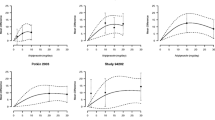Abstract
Dizziness and drowsiness are cited as being predictors of dropout from clinical trials for the medicine pregabalin. These adverse events are typically recorded daily on a four point ordinal scale (0 = none, 1 = mild, 2 = moderate, 3 = severe), with most subjects never reporting either adverse event. We modeled the dizziness, drowsiness, and dropout associated with pregabalin use in generalized anxiety disorder using piecewise Weibull distributions for the time to first non-zero dizziness or drowsiness score, after which the dizziness or drowsiness was modeled with ordinal regression with a Markovian element. Dropout was modeled with a Weibull distribution. Platykurtosis was encountered in the estimated random effects distributions for the ordinal regression models and was addressed with dynamic John–Draper transformations. The only identified predictor for the time to first non-zero dizziness or drowsiness score was daily titrated dose. Predictors for dropout included creatinine clearance and maximum daily adverse event score. Tolerance to adverse events over time was modeled by including a non-stationary component for the dizziness ordinal Markov regression while the piecewise Weibull distributions allowed a change point in the median time to first non-zero dizziness or drowsiness score.










Similar content being viewed by others
References
Lalovic B, Hutmacher MM, Frame B, Ito K, Miller R (2007) Modeling the dropout from longitudinal adverse event data: selecting optimal titration regimens. Abstract 1137. p 16 (www.page-meeting.org/?abstract=1137)
Kowalski KG, McFadyen L, Hutmacher MM, Frame B, and Miller R (2003) A two-part mixture model for longitudinal adverse event data. J Pharmacokin Pharmacodyn 30(5):315–336
Ito K, Hutmacher MM, Liu J, Qiu R, Frame B, Miller R (2008) Exposure-response analysis of spontaneously reported dizziness in pregabalin-treated patient with generalized anxiety disorder. Clin Pharmacol Ther 84:127–135
Arroyo S, Anhut H, Kugler AR, Lee CM, Knapp LE, Garofalo EA et al (2004) Pregabalin add-on treatment: a randomized, double-blind, placebo-controlled, dose-response study in adults with partial seizures. Epilepsia 45:20–27
Pande AC, Feltner DE, Jefferson JW, Davidson JR, Pollack M, Stein MB et al (2004) Efficacy of the novel anxiolytic pregabalin in social anxiety disorder: a placebo-controlled, multicenter study. J Clin Psychopharmacol 24:141–149
Feltner DE, Crockatt JG, Dubovsky SJ, Cohn CK, Shrivastava RK, Targum SD et al (2003) A randomized, double-blind, placebo-controlled, fixed-dose, multicenter study of pregabalin in patients with generalized anxiety disorder. J Clin Psychopharmacol 23:240–249
Pande AC, Crockatt JG, Feltner DE, Janney CA, Smith WT, Weisler R et al (2003) Pregabalin in generalized anxiety disorder: a placebo-controlled trial. Am J Psychiatry 160:533–540
Sabatowski R, Galvez R, Cherry DA, Jacquot F, Vincent E, Maisonobe P et al (2004) Pregabalin reduces pain and improves sleep and mood disturbances in patients with post-herpetic neuralgia: results of a randomised, placebo-controlled clinical trial. Pain 109:26–35
Dworkin RH, Corbin AE, Young JP Jr, Sharma U, LaMoreaux L, Bockbrader H et al (2003) Pregabalin for the treatment of postherpetic neuralgia: a randomized, placebo-controlled trial. Neurology 60:1274–1283
Zingmark PH, Kagedal M, Karlsson MO (2005) Modelling a spontaneously reported side effect by use of a Markov mixed-effects model. J Pharmacokinet Pharmacodyn 32:261–281
Henin E, You B, VanCutsem E, Hoff PM, Cassidy J, Twelves C et al (2009) A dynamic model of hand-and-foot syndrome in patients receiving capecitabine. Clin Pharmacol Ther 85:418–425
Sheiner LB, Beal SL, Dunne A (1997) Analysis of nonrandomly censored ordered categorical longitudinal data from analgesic trials. J Am Stat Assoc 92(440):1235–1255
Noura AA, Read KLQ (1990) Proportional hazards changepoint models in survival analysis. Appl Statist 39:241–253
John JA, Draper NR (1980) An alternative family of transformations. Appl Stat 29:190–197
Boeckmann AJ, Beal SL, Sheiner LB (2006) NONMEM users guide. Parts I–VIII. UCSF, San Francisco CA
Heilbron DC (1994) Zero-altered and other regession models for count data with added zeros. Biomed J 36:531–547
Lambert D (1992) Poisson regression with an application to defects in manufacturing. Technometrics 34:1–14
Aitchison J, Brown JAC (1957) The lognormal distribution. Cambridge University Press, Cambridge
Liu L, Ma JZ, Johnson BA (2008) A multi-level two-part random effects model, with application to an alcohol dependence study. Statst Med 27:3528–3539
Olsen MK, Schafer JL (2001) A two-part random-effects model for semicontinuous longitudinal data. J Am Stat Assoc 96(454):730–745
Cook RJ, Kalbfleisch JD, Yi GY (2002) A generalized mover-stayer model for panel data. Biostatistics 3(3):407–420
Frame B, Beal SL, Miller R, Barrett J, Burger P (2007) Mixed effects modeling of weight change associated with placebo and pregabalin administration. J Pharmacokinet Pharmacodyn 34(6):753–770
Beal SL (2005) Conditioning on certain random events associated with statistical variability in PK/PD. J Pharmacokinet Pharmacodyn 32(2):213–243
Acknowledgement
This work was funded by Pfizer Global Research and Development.
Author information
Authors and Affiliations
Corresponding author
Rights and permissions
About this article
Cite this article
Frame, B., Miller, R. & Hutmacher, M.M. Joint modeling of dizziness, drowsiness, and dropout associated with pregabalin and placebo treatment of generalized anxiety disorder. J Pharmacokinet Pharmacodyn 36, 565–584 (2009). https://doi.org/10.1007/s10928-009-9137-5
Received:
Accepted:
Published:
Issue Date:
DOI: https://doi.org/10.1007/s10928-009-9137-5




